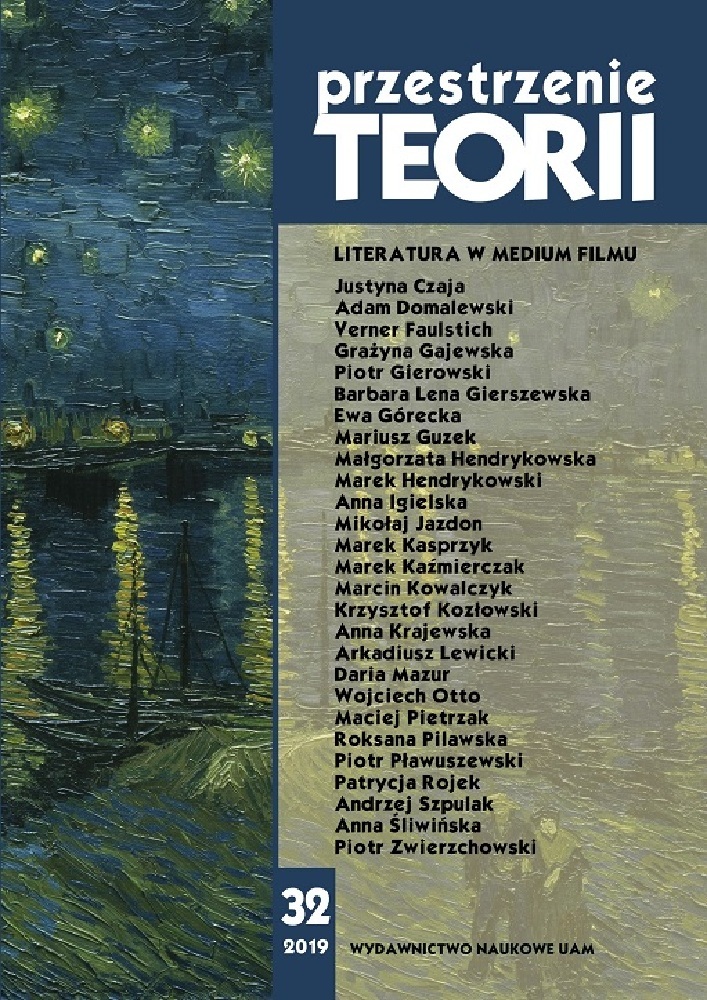Abstrakt
Kozłowski Krzysztof, Wiersz o jesieni. O Frantzu François Ozona [A Poem on Autumn. Frantz by François Ozon]. „Przestrzenie Teorii” 32. Poznań 2019, Adam Mickiewicz University Press, pp. 77–92. ISSN 1644-6763. DOI 10.14746/pt.2019.32.3.
The film Broken Lullaby ([1932] Ernst Lubitsch) and the novel L’Homme que j’ai tué ([1921, 1925, 1930] Maurice Rostand) are seen to be the main inspirations for Frantz (2016) by François Ozon. On the basis of methodology broadly understood as the concept of bringing into relief (Domański, 1992, 2002), this article aims to demonstrate the means by which the French director expanded upon the literary-film material, imbuing it with a totally singular meaning. Ozon’s inventiveness did not
limit itself to transformations typical for adaptations, but ventured towards feature film understood as a synthetic work of art that by exploiting the audiovisual properties of the medium itself, acts as a unifying force of poetry (Verlaine, Banville), music (Chopin, Debussy) and painting (Manet). The famous poem recited by the heroine, Ann, Chanson d’automne (Paul Verlaine), serves as the analytical starting point for the above. It is thus used as a pivot for the entire film, a veritable lodestar
for guiding motifs, allowing important aspects of the film to be highlighted and consequently, bring its main theme to the fore.
Finansowanie
Verlaine
music
painting
pacifism
love
forgiveness
untruth
Bibliografia
Ahrens B., Die Dejeuner-Malerei von Edouard Manet, Claude Monet und Pierre-Auguste Renoir. Untersuchung zur Darstellung von Mahlzeiten in der Zeit des französischen Impressionismus, Ludwigshafen am Rhein 2006 [maszynopis].
Banville Th. de, Les Stalactites; Odelettes; Amethystes; Le Forgeron, Paris 1889.
Bildanalysen: Gemälde, Fotos, Werbebilder, hrsg. von W. Faulstich, Bardowick 2010.
Domański J., Tekst jako uobecnienie. Szkic z dziejów myśli o piśmie i książce, Kęty 20022.
Eliot T.S., Od Poego do Valéry’ego, [w:] tegoż, Szkice krytyczne, wybrała, przełożyła i wstępem opatrzyła M. Niemojowska, Warszawa 1972, s. 105–126.
Elsaesser Th., Das Weimarer Kino – aufgeklärt und doppelbödig, Berlin 1999.
Faulstich W., Estetyka filmu. Badania nad filmem science fiction „Wojna światów” (1953/1954) Byrona Haskina, przeł. M. Kasprzyk, K. Kozłowski, przedmową poprzedził i oprac. K. Kozłowski, Poznań 2017 („Biblioteka «Przestrzenie Teorii»”).
Faulstich W., Filmgeschichte, Paderborn 2005.
Friedrich H., Struktura nowoczesnej liryki. Od połowy XIX do połowy XX wieku, przeł. i opatrzyła wstępem E. Feliksiak, Warszawa 1978.
Gadamer H.-G., Poetica. Wybrane eseje, przeł. M. Łukasiewicz, Warszawa 2001 („Archiwum Humanistyki XX wieku”).
George S., Gesamt-Ausgabe der Werke, t. 16: Zeitgenössische Dichter. Übertragungen, cz II: Verlaine, Mallarmé, Rimbaud, de Régnier, D’Annunzio, Rolicz-Lieder, Berlin 1929.
Hammerstein R., Die Stimme aus der anderen Welt. Über die Darstellung des Numinosen in der Oper von Monteverdi bis Mozart, Tutzing 1998.
Hirsbrunner Th., Debussy und seine Zeit, Laaber 1981 („Große Komponisten und ihre Zeit”).
Jarociński S., Debussy a impresjonizm i symbolizm, Kraków 1966.
Juszczak W., Malarstwo polskie. Modernizm, Gdańsk 20052.
Kilb A., Diese Liebe beginnt mit einer Schusswunde, „Frankfurter Allgemeine Zeitung” 2016 (29 września); <https://www.faz.net/aktuell/feuilleton/kino/grosses-franzoesisches-kino-francois-ozons-frantz-14457832-p2.html?printPagedArticle=true#page-Index_1> [dostęp: 16.02.2020].
Kunze S., Der Sprechgesang und das Unsagbare. Bemerkungen zu „Pelléas et Mélisande” von Debussy, [w:] Analysen. Beiträge zu einer Problemgeschichte des Komponierens. Festschrift für Hans Heinrich Eggebrecht zum 65. Geburtstag, hrsg. von W. Breig, R. Brinkmann und E. Budde, Stuttgart 1984.
Mallarmé S., Wybór poezji, redagował A. Ważyk, Warszawa 1980.
Nochlin L., Realizm, przeł. W. Juszczak, T. Przestępski, Warszawa 1974.
Okulicz-Kozaryn R., Litwin wśród spadkobierców Króla-Ducha. Twórczość Čiurlionisa wobec Młodej Polski, Poznań 2007.
Osthoff W., Stefan George und „les deux musiques”, Stuttgart 1989.
Peyre H., Co to jest symbolizm?, przeł. i posłowiem opatrzył M. Żurowski, Warszawa 1990.
Praz M., Zmysły, śmierć i diabeł w literaturze romantycznej, przeł. K. Żaboklicki, wstęp M. Brahmer, Gdańsk 20102 („Klasyka Światowej Humanistyki”).
Rilke R.M., Poezje, wybrał, przeł. i posłowiem opatrzył M. Jastrun, Kraków 1987.
Rostand M., L’Homme que j’ai tué, „Les OEuvres Libres” 1921, nr 3 (sept.), s. 169–215.
Rostand M., L’Homme que j’ai tué, Paris 1925.
Rostand M., L’Homme que j’ai tué, Paris 1934.
Rostand M., L’Homme que j’ai tué. Pièce en 3 actes et un prologue, b.m. [Paris?] 1930.
Rymkiewicz J.M., Myśli różne o ogrodach, Warszawa 20102.
Thibaudet A., Historia literatury francuskiej. Od Rewolucji Francuskiej do lat trzydziestych XX wieku, przeł. J. Guze, Warszawa 1997.
Tomaszewski M., Chopin. Człowiek, dzieło, rezonans, Kraków 20102.
Valéry P., Estetyka słowa. Szkice, wybór A. Frybesowej, wstęp M. Żurowskiego, przeł. D. Eska, A. Frybesowa, Warszawa 1971.
Valéry P., Rzeczy przemilczane (Z pism o sztuce), wybór, przekład i noty J. Guze, Warszawa 1974.
Verlaine P., Wybór poezji, oprac. A. Drzewicka, Warszawa i in. 1980, „Biblioteka Narodowa”, seria II, nr 200.
Licencja
Autorzy
Autorzy tekstów przyjętych do publikacji w czasopiśmie „Przestrzeniach Teorii” są zobowiązani do wypełnienia, podpisania i odesłania na adres redakcji umowy o udzielenie nieodpłatnej licencji do utworów, z zobowiązaniem do udzielania sublicencji CC.
Zgodnie z umową, autorzy tekstów opublikowanych w czasopiśmie „Przestrzeniach Teorii” udzielają Uniwersytetowi im. Adama Mickiewicza w Poznaniu niewyłącznej i nieodpłatnej licencji oraz zezwalą na użycie sublicencji Creative Commons Attribution-NonCommercial-NoDerivatives 4.0 International (CC BY-NC-ND 4.0).
Autorzy zachowują prawa do dalszego, swobodnego rozporządzania utworem.
Autorzy, którzy wykorzystują w swoim tekście cudze utwory (np. ilustracje, fotografie) proszeni są o dostarczenie do redakcji czasopisma zgodę na publikację od uprawnionych podmiotów.
Użytkownicy
Zainteresowani użytkownicy internetu uprawnieni są do korzystania z utworów opublikowanych po 2015 roku „Przestrzeniach Teorii” tylko w calach niekomercyjnych, pod następującymi warunkami:
- uznanie autorstwa - obowiązek podania wraz z rozpowszechnionym utworem, informacji, o autorstwie, tytule, źródle (odnośniki do oryginalnego utworu, DOI) oraz samej licencji;
- bez tworzenia utworów zależnych - utwór musi być zachowany w oryginalnej postaci, nie można bez zgody twórcy rozpowszechniać np. tłumaczeń, opracowań.
Do wszystkich tekstów opublikowanych przed 2015 r. prawa autorskie są zastrzeżone.
Inne
Uniwersytet im. Adama Mickiewicza w Poznaniu zachowuje prawo do czasopisma jako całości (układ, forma graficzna, tytuł, projekt okładki, logo itp.).

